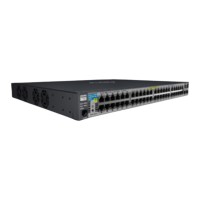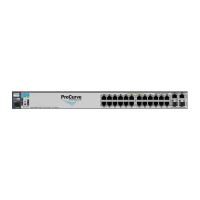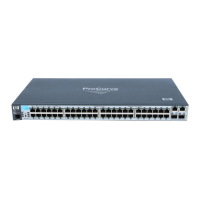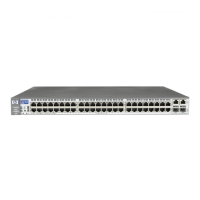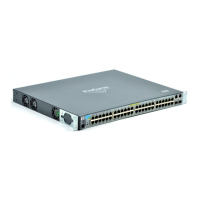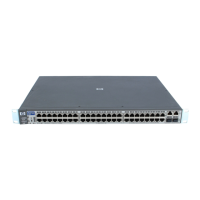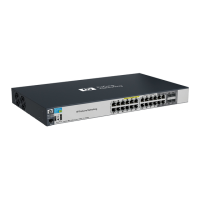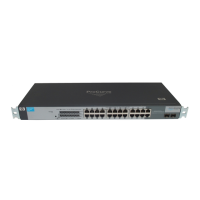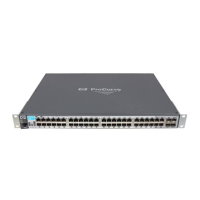What to do if HP Switch cables are faulty?
- AanielsenAug 1, 2025
If the cables appear to be OK, ensure the connections are snug. If the problem persists, try using a different cable.
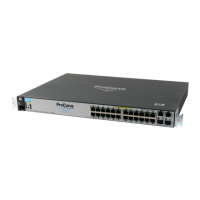
What to do if HP Switch cables are faulty?
If the cables appear to be OK, ensure the connections are snug. If the problem persists, try using a different cable.
How to fix non-standard cables on HP Switch?
Use a new, correctly-wired cable, or compare your cable to the cable in appendix B, “Switch Ports and Network Cables” for pinouts and correct cable wiring.
Why is my HP ProCurve 2610 port not operating as expected?
Use the switch console to determine the port’s configuration and verify that there is not an improper or undesired configuration of any of the switch features that may be affecting the port.
| Switching Capacity | 12.8 Gbps |
|---|---|
| Forwarding Rate | 9.5 Mpps |
| MAC Address Table Size | 8000 entries |
| Layer | Layer 2 |
| RAM | 64 MB |
| Flash Memory | 16 MB |
| Jumbo Frame Support | Yes |
| Manageable | Yes |
| Operating Humidity | 15% to 95% non-condensing |
| Ports | 24 x 10/100 |
| VLANs | 256 |
| Management | Web, CLI, SNMP |
| Power Supply | Internal |
| Operating Temperature | 0°C to 40°C |
| Dimensions (W x D x H) | 17.42 x 12.73 x 1.73 in |
Lists printed manuals shipped with the switch.
Lists electronic manuals available on the ProCurve website.
Introduces the guide and supported switches.
Explains conventions used in the guide for syntax and display.
Explains basic IP address configuration steps.
Directs users to the Installation guide for physical setup.
Introduces static, port-based VLAN configuration.
Details features and maximums for static VLANs.
Discusses the importance and configuration of the primary VLAN.
Details options for assigning individual ports to static VLANs.
Details how to configure VLAN parameters via the menu interface.
Explains how to configure VLANs using the Command Line Interface.
Describes how VLAN tagging enables multiple VLANs on a single port.
Explains creating a secure VLAN for managing switches.
Introduces GVRP and its relation to VLANs.
Explains how GVRP operates by advertising and joining VLANs.
Describes procedures for viewing, enabling, and configuring GVRP.
Explains GVRP configuration using the Command Line Interface.
Introduces IGMP for reducing bandwidth usage in multimedia traffic.
Lists available IGMP features and their configuration methods.
Details IGMP configuration and display commands via CLI.
Describes the operational flow of IGMP.
Explains automatic fast-leave IGMP operation.
Explains forced fast-leave IGMP functionality.
Describes IP multicast filtering for excluding specific addresses.
Describes the options available for RSTP and STP.
Explains the IEEE 802.1w Rapid Reconfiguration Spanning Tree protocol.
Details the IEEE 802.1D Spanning Tree Protocol.
Guides on configuring RSTP operation and parameters.
Provides recommendations for optimizing RSTP setup.
Explains RSTP configuration using the Command Line Interface.
Describes STP Fast Mode for overcoming server access failures.
Explains Fast-Uplink STP for improving convergence time.
Details the IEEE 802.1s Multiple Spanning Tree Protocol.
Explains the structure and components of MSTP networks.
Outlines the general steps for configuring MSTP operation.
Introduces QoS for traffic management and bandwidth control.
Details QoS classifiers for prioritizing outbound traffic.
Guides on preparing for QoS configuration.
Discusses planning QoS configurations and resource usage.
Guides on using QoS classifiers for outbound traffic.
Details configuring QoS priority based on UDP/TCP port.
Explains QoS priority based on IP address.
Explains QoS priority based on VLAN ID.
Explains QoS priority based on source port.
Explains how to map DSCP codepoints to 802.1p priorities.
Discusses how IGMP interacts with QoS.
Provides notes and restrictions for QoS operation.
Introduces IP static routing and its configuration.
Explains IP tables and caches like ARP and route tables.
Guides on configuring IP parameters for routing switches.
Guides on configuring static IP routes.
Explains how to configure the default route for traffic.
Explains the ICMP Router Discovery Protocol configuration.
Explains the configuration of DHCP relay agents.
Discusses DHCP Option 82 and its advantages.
Explains how to configure UDP broadcast forwarding.
Guides on configuring and globally enabling UDP broadcast forwarding.
Introduces switch stacking concepts and features.
Details stacking features and operations.
Lists ProCurve devices that support stacking.
Explains the general process of configuring and operating stacks.
Guides on configuring stack management.
Outlines the process of setting up a stack.
Details viewing and configuring a Commander switch via menu.
Explains how to manage a Candidate switch via menu.
Guides on managing the stack via the Commander.
Guides on viewing status and configuring stacking via CLI.
Guides on configuring a switch as a Commander via CLI.
Details converting a stack member to a new stack commander via CLI.
Explains how to remove a member from a stack via CLI.
Guides on accessing member switches for configuration and monitoring via CLI.
Discusses SNMP community operation within a stack.
Explains how to disable or re-enable stacking via CLI.
Explains viewing and configuring stacking via web browser.
Lists and explains stacking status messages.
